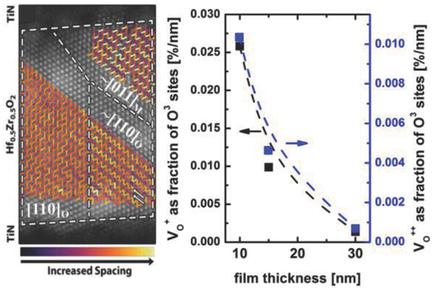当前位置:
X-MOL 学术
›
Adv. Electron. Mater.
›
论文详情
Our official English website, www.x-mol.net, welcomes your feedback! (Note: you will need to create a separate account there.)
Analysis of Performance Instabilities of Hafnia‐Based Ferroelectrics Using Modulus Spectroscopy and Thermally Stimulated Depolarization Currents
Advanced Electronic Materials ( IF 6.2 ) Pub Date : 2018-02-01 , DOI: 10.1002/aelm.201700547 Franz P. G. Fengler 1 , Robin Nigon 2 , Paul Muralt 2 , Everett D. Grimley 3 , Xiahan Sang 4 , Violetta Sessi 5 , Rico Hentschel 1 , James M. LeBeau 3 , Thomas Mikolajick 5 , Uwe Schroeder 1
Advanced Electronic Materials ( IF 6.2 ) Pub Date : 2018-02-01 , DOI: 10.1002/aelm.201700547 Franz P. G. Fengler 1 , Robin Nigon 2 , Paul Muralt 2 , Everett D. Grimley 3 , Xiahan Sang 4 , Violetta Sessi 5 , Rico Hentschel 1 , James M. LeBeau 3 , Thomas Mikolajick 5 , Uwe Schroeder 1
Affiliation

|
The discovery of the ferroelectric orthorhombic phase in doped hafnia films has sparked immense research efforts. Presently, a major obstacle for hafnia's use in high‐endurance memory applications like nonvolatile random‐access memories is its unstable ferroelectric response during field cycling. Different mechanisms are proposed to explain this instability including field‐induced phase change, electron trapping, and oxygen vacancy diffusion. However, none of these is able to fully explain the complete behavior and interdependencies of these phenomena. Up to now, no complete root cause for fatigue, wake‐up, and imprint effects is presented. In this study, the first evidence for the presence of singly and doubly positively charged oxygen vacancies in hafnia–zirconia films using thermally stimulated currents and impedance spectroscopy is presented. Moreover, it is shown that interaction of these defects with electrons at the interfaces to the electrodes may cause the observed instability of the ferroelectric performance.
中文翻译:

基于Mod谱的铁电体性能不稳定性的模量光谱分析和热激励去极化电流
掺杂氧化f薄膜中铁电正交晶相的发现引发了巨大的研究努力。目前,ha在诸如非易失性随机存取存储器之类的高耐久性存储应用中使用的主要障碍是其在磁场循环过程中不稳定的铁电响应。提出了多种机制来解释这种不稳定性,包括场致相变,电子俘获和氧空位扩散。但是,这些都不能完全解释这些现象的完整行为和相互依赖性。到目前为止,还没有出现疲劳,唤醒和压印效果的完整根本原因。在这项研究中,首先提供了使用热激发电流和阻抗光谱法在氧化锆-氧化锆薄膜中存在单双电荷带正电荷的氧空位的证据。此外,已经表明,这些缺陷与电极界面处的电子相互作用可能导致所观察到的铁电性能的不稳定性。
更新日期:2018-02-01
中文翻译:

基于Mod谱的铁电体性能不稳定性的模量光谱分析和热激励去极化电流
掺杂氧化f薄膜中铁电正交晶相的发现引发了巨大的研究努力。目前,ha在诸如非易失性随机存取存储器之类的高耐久性存储应用中使用的主要障碍是其在磁场循环过程中不稳定的铁电响应。提出了多种机制来解释这种不稳定性,包括场致相变,电子俘获和氧空位扩散。但是,这些都不能完全解释这些现象的完整行为和相互依赖性。到目前为止,还没有出现疲劳,唤醒和压印效果的完整根本原因。在这项研究中,首先提供了使用热激发电流和阻抗光谱法在氧化锆-氧化锆薄膜中存在单双电荷带正电荷的氧空位的证据。此外,已经表明,这些缺陷与电极界面处的电子相互作用可能导致所观察到的铁电性能的不稳定性。



























 京公网安备 11010802027423号
京公网安备 11010802027423号